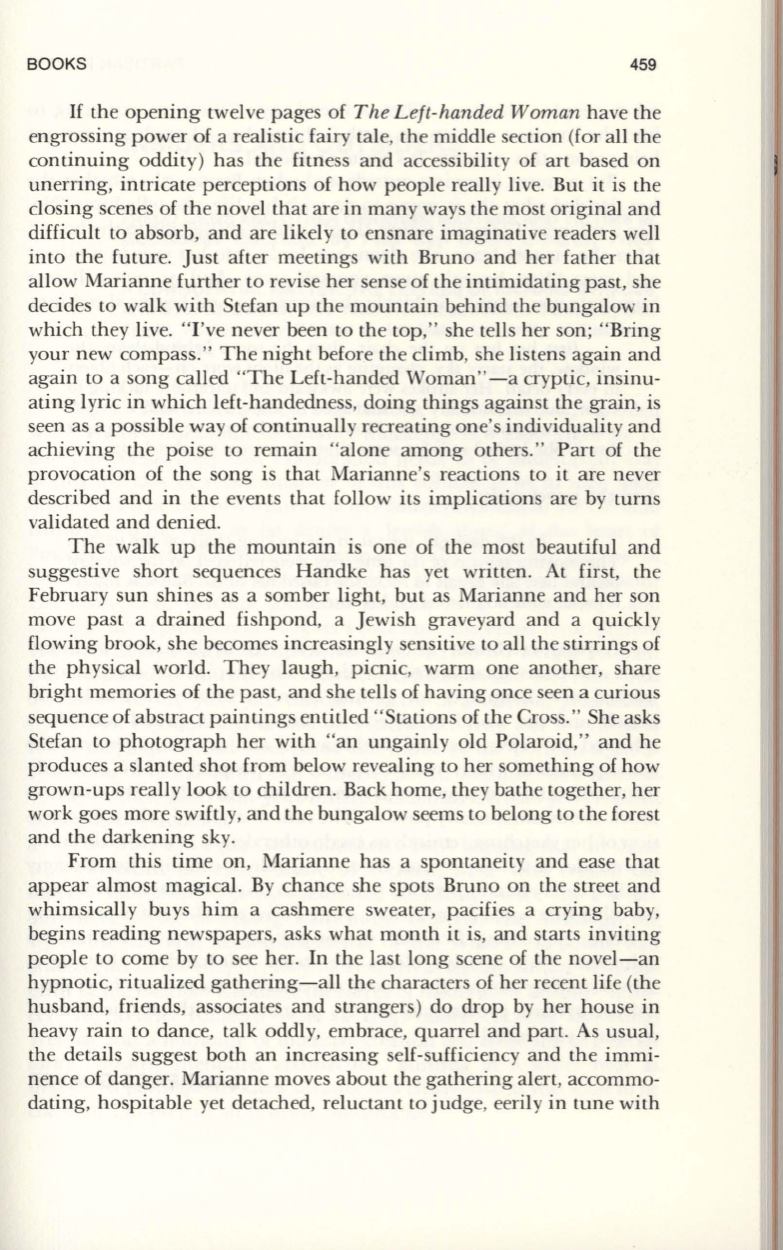
BOOKS
459
If
the opening twelve pages of
The Left-handed Woman
have the
engrossing power of a realistic fairy tale, the middle section (for all the
continuing oddity) has the fitness and accessibility of art based on
unerring, intricate perceptions of how people really live. But it is the
closing scenes of the novel that are in many ways the most original and
difficult
to
absorb, and are likely to ensnare imaginative readers well
into the future. Just after meetings with Bruno and her father that
allow Marianne further to revise her sense of the intimidating past, she
decides to walk with Stefan up the mountain behind the bungalow in
which they live. "I've never been
to
the top," she tells her son; "Bring
your new compass." The night before the climb, she listens again and
again
to
a song called "The Left-handed Woman" -a cryptic, insinu–
ating lyric in which left-handedness, doing things against the grain, is
seen as a possible way of continually recreating one's individuality and
achieving the poise to remain "alone among others. " Part of the
provocation of the song is that Marianne's reactions to it are never
described and in the events that follow its implications are by turns
validated and denied.
The walk up the mountain is one of the most beautiful and
suggestive short sequences Handke has yet written. At first, the
February sun shines as a somber light, but as Marianne and her son
move past a drained fishpond, a Jewish graveyard and a quickly
flowing brook, she becomes increasingly sensitive to all the stirrings of
the physical world. They laugh, picnic, warm one another, share
bright memories of the past, and she tells of having once seen a curious
sequence of abstract paintings entitled " Stations of the Cross." She asks
Stefan to photograph her with "an ungainly old Polaroid," and he
produces a slanted shot from below revealing to her something of how
grown-ups really look to children. Back home, they bathe together, her
work goes more swiftl y, and the bungalow seems to belong to the forest
and the darkening sky.
From this time on, Marianne has a spontaneity and ease that
appear almost magical. By chance she spots Bruno on the street and
whimsically buys him a cashmere sweater, pacifies a crying baby,
begins reading newspapers, asks what month it is, and starts inviting
people to come by
to
see her. In the last long scene of the novel-an
hypnotic, ritualized gathering-all the characters of her recent life (the
husband, friends, associates and strangers) do drop by her house in
heavy rain to dance, talk oddly, embrace, quarrel and part. As usual,
the details suggest both an increasing self-sufficiency and the immi–
nence of danger. Marianne moves about the gathering alert, accommo–
dating, hospitable yet detached, reluctant to judge, eerily in tune with


